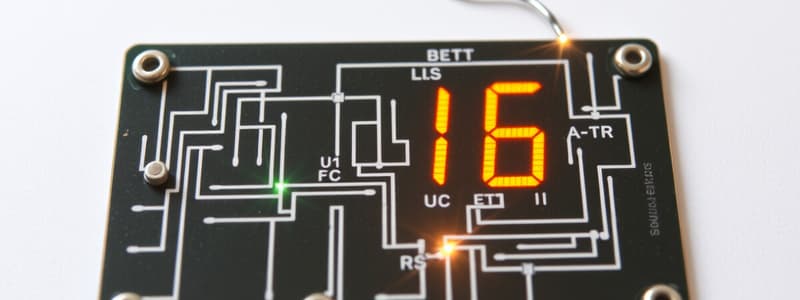Podcast
Questions and Answers
What is the unit of measure for resistance?
What is the unit of measure for resistance?
- Ohms (Ω) (correct)
- Volts (V)
- Watts (W)
- Amperes (A)
In a series circuit, which of the following statements is true?
In a series circuit, which of the following statements is true?
- Current splits among the components.
- Total resistance is the sum of individual resistances. (correct)
- Voltage across each component is the same.
- Total power is constant.
According to Kirchhoff's Voltage Law, what can be said about the voltage around any closed loop in a circuit?
According to Kirchhoff's Voltage Law, what can be said about the voltage around any closed loop in a circuit?
- It equals the total voltage from the power supply.
- It must equal the sum of the source voltages only.
- It must equal zero. (correct)
- It equals the total resistance in the circuit.
In a parallel circuit, which statement is correct regarding the voltage across the resistors?
In a parallel circuit, which statement is correct regarding the voltage across the resistors?
What is the expression for total resistance (R_total) in a parallel circuit?
What is the expression for total resistance (R_total) in a parallel circuit?
In the context of Kirchhoff's Current Law, what does the formula ΣI_in = ΣI_out signify?
In the context of Kirchhoff's Current Law, what does the formula ΣI_in = ΣI_out signify?
Which of the following statements about power in a circuit is true?
Which of the following statements about power in a circuit is true?
What happens to the total resistance when additional resistors are added in series?
What happens to the total resistance when additional resistors are added in series?
Which factor does NOT affect the total current in a circuit?
Which factor does NOT affect the total current in a circuit?
What is the derived formula for power using Ohm's Law?
What is the derived formula for power using Ohm's Law?
Flashcards are hidden until you start studying
Study Notes
Current Electricity Study Notes
Circuit Analysis
- Current (I): Flow of electric charge, measured in amperes (A).
- Voltage (V): Electric potential difference, measured in volts (V).
- Resistance (R): Opposition to current flow, measured in ohms (Ω).
- Ohm's Law: V = I × R; relates voltage, current, and resistance in a circuit.
- Power (P): Rate of energy transfer; P = V × I; measured in watts (W).
- Series Circuit: Current is the same through all components; total resistance (R_total) = R1 + R2 + ... + Rn.
- Parallel Circuit: Voltage is the same across all components; total resistance (R_total) is given by 1/R_total = 1/R1 + 1/R2 + ... + 1/Rn.
Resistors in Series and Parallel
-
Series Configuration:
- Current (I) is constant through each resistor.
- Total resistance increases: R_total = R1 + R2 + ... + Rn.
- Voltage drops sum up to the total voltage: V_total = V1 + V2 + ... + Vn.
-
Parallel Configuration:
- Voltage (V) is constant across all resistors.
- Total resistance decreases: 1/R_total = 1/R1 + 1/R2 + ... + 1/Rn.
- Current splits across branches: I_total = I1 + I2 + ... + In.
Kirchhoff's Laws
-
Kirchhoff's Current Law (KCL):
- At any junction in a circuit, the sum of currents entering the junction equals the sum of currents leaving it.
- Formula: ΣI_in = ΣI_out.
-
Kirchhoff's Voltage Law (KVL):
- The sum of the electrical potential differences (voltage) around any closed loop in a circuit must equal zero.
- Formula: ΣV = 0 for a closed loop; includes source voltages and voltage drops across components.
-
Application of KCL and KVL:
- Use KCL to analyze current distribution in parallel circuits.
- Use KVL to determine voltages in series circuits or complex loops.
These principles form the foundation for analyzing electrical circuits and understanding how current flows through different components.
Circuit Analysis
- Current (I) is the flow of electric charge, measured in amperes (A).
- Voltage (V) represents the electric potential difference, measured in volts (V).
- Resistance (R) is the opposition to current flow, measured in ohms (Ω).
- Ohm's Law states that Voltage (V) equals Current (I) multiplied by Resistance (R): V = I × R.
- Power (P) indicates the rate of energy transfer, calculated as P = V × I and measured in watts (W).
- Series Circuit: All components carry the same current; the total resistance is the sum of individual resistances: R_total = R1 + R2 +...+ Rn.
- Parallel Circuit: All components share the same voltage; total resistance decreases according to: 1/R_total = 1/R1 + 1/R2 +...+ 1/Rn.
Resistors in Series and Parallel
- In a Series Configuration:
- The current remains constant throughout each resistor.
- Total resistance increases as R_total = R1 + R2 +...+ Rn.
- The sum of voltage drops across each resistor equals the total voltage: V_total = V1 + V2 +...+ Vn.
- In a Parallel Configuration:
- The voltage across each resistor is constant.
- Total resistance decreases, calculated as: 1/R_total = 1/R1 + 1/R2 +...+ 1/Rn.
- Current splits across the branches, with the total current represented as: I_total = I1 + I2 +...+ In.
Kirchhoff's Laws
- Kirchhoff's Current Law (KCL) states that at any junction in a circuit, the total current entering the junction equals the total current leaving it, expressed as: ΣI_in = ΣI_out.
- Kirchhoff's Voltage Law (KVL) states that the sum of electrical potential differences in a closed loop must equal zero, expressed as: ΣV = 0; this includes both source voltages and voltage drops across components.
- Application of KCL and KVL:
- KCL is utilized for analyzing current distribution in parallel circuits.
- KVL is applied to calculate voltages within series circuits or more complex loops.
Studying That Suits You
Use AI to generate personalized quizzes and flashcards to suit your learning preferences.




